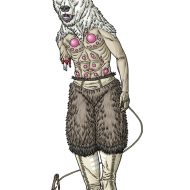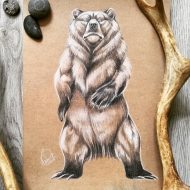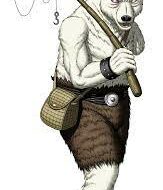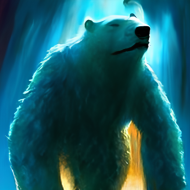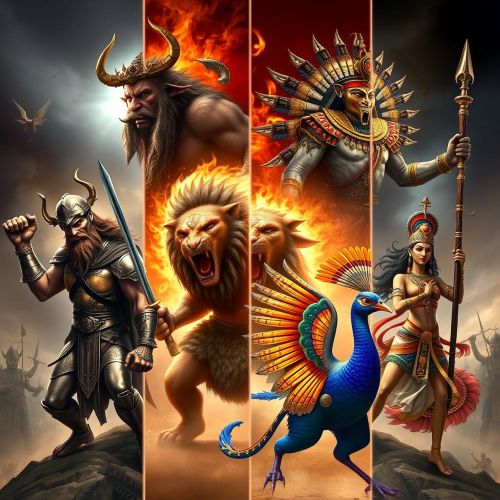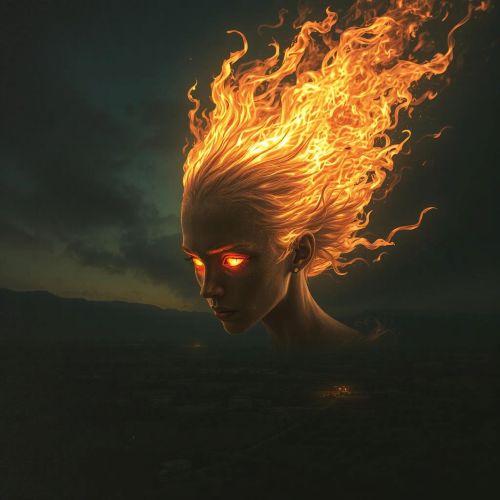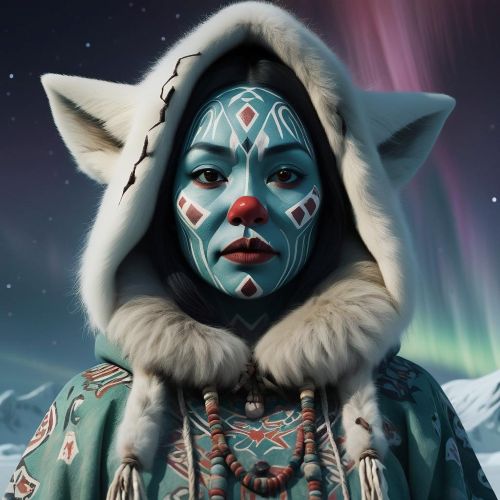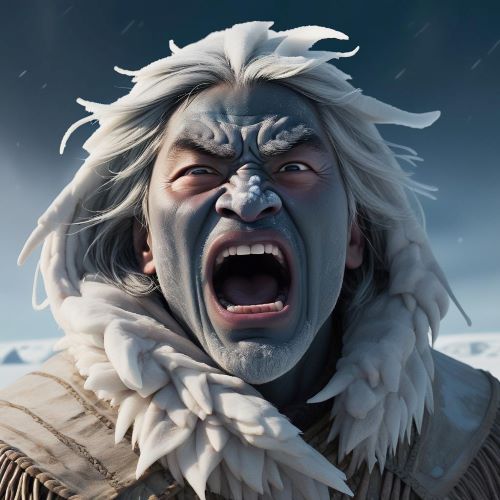Torngarsuk : The Sky God
Listen
At a glance
| Description | |
|---|---|
| Origin | Inuit Mythology |
| Classification | Spirits |
| Family Members | N/A |
| Region | Greenland |
| Associated With | Sky, Hunting |
Torngarsuk
Introduction
Torngarsuk, a mysterious and powerful figure, reigns supreme within the Inuit pantheon. This complex deity embodies the vastness of the sky, the chilling embrace of death, and the secrets of the underworld, shaping Inuit cultural practices and instilling a deep respect for the natural world. Revered as a sea, death, and underworld god, Torngarsuk holds a prominent place in Inuit mythology.
Known also as the sky god, Torngasak, he is regarded as the leader of the protective gods, the Trungasat. In the Dictionnaire Infernal, he is listed as a spirit or demon. Among the Inuit people, who inhabit the Arctic regions of Canada, Greenland, and Alaska, Torngarsuk stands out as a powerful and enigmatic figure, associated with hunting, shamanism, and the natural elements. As the master of the animals and a protector of hunters, he is both feared and respected.
Physical Traits
Describing Torngarsuk’s physical form is challenging due to his ability to appear in various guises. Some tales depict him as a monstrous bear, symbolizing the unforgiving power of nature, while others describe him as a one-armed man, highlighting human vulnerability. Another evocative image portrays him as a colossal human finger, emphasizing his immense power and celestial connection. These conflicting descriptions make his true form elusive, known only to the angakkuit, the revered Inuit shamans.
In some accounts, he is a massive white bear residing in a Hudson Strait cave, the master of seals and whales. Other sources describe him as invisible, seen only by the angakkuit. This variety in his depiction underscores his shapeshifting abilities, a common trait among many Inuit deities. Despite these differing portrayals, a consistent element is the aura of power and mystery that surrounds him, commanding respect in any form he takes. This versatility highlights his role as a master of the natural world and a bridge between different realms of existence.
Family
The familial connections of Torngarsuk are not extensively detailed in Inuit mythology, where the focus is more on his interactions with humans and his role within the Arctic’s spiritual ecosystem. He is often considered part of a broader pantheon of spirits and deities, forming a complex web of relationships that influence the natural world and human society. In some myths, Torngarsuk is depicted as a leader or high-ranking member of the spirit world, suggesting a hierarchical structure among the deities and cementing his importance in maintaining balance and order in the Arctic environment.
Torngarsuk’s familial ties are as enigmatic as his physical form. He is frequently referred to as the leader of the Tornat, a group of powerful spirits who act as guardians of the Inuit. The nature of this leadership is unclear—whether the Tornat are his children, servants, or manifestations of his multifaceted nature remains unknown. Legends provide no definitive answers, leaving scholars to ponder the intricate web of relationships within the Inuit spirit world.
Torngarsuk’s lineage intertwines with the fabric of existence. As the master of whales and seals, he commands the oceanic realms and assumes a leadership role among the Tornat, guiding these protective gods. This connection reinforces his role in safeguarding the Inuit community and highlights his significance in the spiritual hierarchy.
Other names
Torngarsuk’s name varies across Inuit communities, reflecting the cultural diversity of the Arctic. He is known as Tornasuk, Tornaq, Tungrangayak, Tornatik, and Torngarsoak, with each name emphasizing different aspects of his multifaceted nature. These variations arise from regional dialects and oral storytelling traditions, highlighting his omnipresence and enduring influence in Inuit mythology. Despite the different names, Torngarsuk’s essence remains consistent—a powerful, mischievous spirit revered by those who seek his favor or invoke his aid. This multiplicity underscores his widespread reverence among the Inuit people and his significant role in their spiritual and cultural landscape.
Powers and Abilities
Torngarsuk wields formidable abilities, controlling whales and seals, thereby influencing life and death in Arctic waters. As a guardian of the underworld, he bridges the realms of the living and the departed, his invisibility to all but the angakkuit enhancing his mystique and connection to the spirit world. This shapeshifting deity can appear as a polar bear, human, or invisible spirit, navigating both physical and spiritual worlds to aid hunters and guide shamans.
Hunters revere Torngarsuk as the master of the hunt, with whales and seals answering his call. His blessing is crucial for successful hunts, underscoring the symbiotic relationship between the Inuit and their environment. Torngarsuk’s power manifests in various forms, from natural phenomena to guiding spirits, emphasizing his adaptability and influence.
The angakkuit, or shamans, maintain a special connection to Torngarsuk, acting as intermediaries between humans and spirits. Through rituals and incantations, they seek his favor, crucial for community survival in the harsh Arctic environment. Torngarsuk’s wrath, manifesting as storms, illness, or misfortune, underscores the importance of appeasing him to ensure balance and prosperity.
Modern Day Influence
The influence of Torngarsuk extends beyond traditional Inuit mythology into contemporary culture. As interest in indigenous cultures grows, Torngarsuk has become a subject of study for scholars, artists, and the public alike. His stories and attributes are explored in academic research, offering insights into Inuit beliefs and their ecological perspectives. In literature, art, and film, Torngarsuk appears as a symbol of Inuit strength and resilience, often portrayed with his shapeshifting abilities and deep connection to nature, resonating themes of transformation and harmony.
In today’s world, Torngarsuk remains relevant amidst environmental and cultural challenges faced by Arctic communities. As a guardian of the natural world and a symbol of balance, he underscores the importance of respecting and conserving the environment. Efforts to preserve indigenous knowledge highlight figures like Torngarsuk, emphasizing their ongoing significance in addressing contemporary issues.
In popular culture, Torngarsuk’s legacy continues to inspire. From H.P. Lovecraft’s portrayal in “The Call of Cthulhu” where Torngarsuk is associated with a cult of Eskimo diabolists, to Marvel Comics’ adaptation linking him with Anguta and Tulugaak as Hodiak, Torngarsuk’s presence transcends ancient myths. He remains a potent symbol, reminding us of the enduring power of the natural world and the mysteries that endure beyond human understanding.
Related Images
Frequently Asked Questions
What is a Torngarsuk?
Torngarsuk, a shapeshifting Inuit deity, reigns over the sky, death, and the underworld. He controls the hunt, ensuring the bounty of the sea, and leads the Tornat, guardian spirits. This enigmatic figure, also known as Tornasuk or Tornaq, embodies the power and mystery of the natural world, a force both revered and appeased by the Inuit people.
What are the Inuit people's religious beliefs?
The Inuit traditionally held an animistic worldview, believing all things possessed spirits. Nature, animals, and even objects held power that needed to be respected. Shamans, or angakkuit, acted as spiritual bridges, communicating with these spirits to ensure a successful hunt and maintain harmony with the environment. While Christianity has become widespread, these core beliefs continue to influence Inuit culture, shaping their deep respect for the natural world.
What is adlivun?
Adlivun, in Inuit mythology, refers to both the destination of souls after death and the underworld itself. Imagine it as a frozen wasteland beneath the earth and sea, where spirits reside before their next journey. This realm, ruled by the powerful Torngarsuk, serves as a temporary resting place for the departed.
Who is the Inuit god of the underworld?
The Inuit god of the underworld is Torngarsuk. He’s a complex and powerful deity who also holds dominion over death, the hunt, and even shapeshifting. Understanding Torngarsuk is key to unlocking the deeper meaning of the Inuit relationship with nature and the spirit world.

